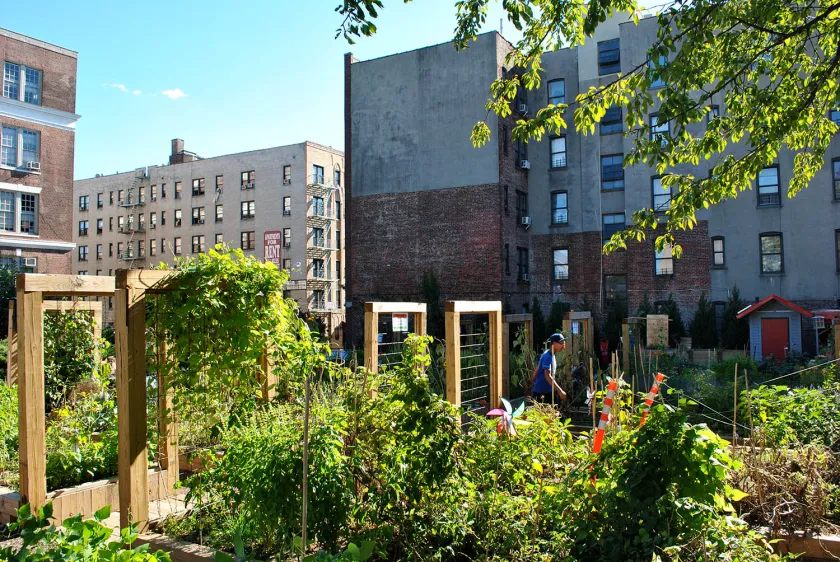You’re walking through Manhattan, surrounded by asphalt, steel, glass, and brick. Suddenly, you hear happy voices floating on the air, and come upon an oasis of green, teeming with people of all ages and backgrounds. Welcome to your community garden—a place to learn, destress, and heal.
Gardens have long been known for their healing effects, used from ancient Egypt to the Roman Empire as places of respite and restoration. Throughout history, hospitals have been accompanied by gardens, for both medicinal and therapeutic purposes. However, modern urban sprawl has often overlooked the importance of such spaces, leaving millions around the world with limited access to the nature our ancestors so deeply valued.
A growing movement of urban gardening aims to reverse this trend, changing the landscape of our cities one plot of land at a time. In New York State, the Department of Health and the Department of Agriculture and Markets have both launched major community garden initiatives in the last twenty years, while The Wilderness Society, through its Urban to Wild program, has worked to increase numbers of urban green spaces and access in California, Washington, and New Mexico. In this article, we will explore the myriad benefits of community gardens, their role in urban design, and successful initiatives that demonstrate their positive impact on both individuals and communities.
The Benefits of Community Gardens
Working in a garden offers numerous benefits to improve physical well-being. Spending time in the sun can lower blood pressure, pulse rate, and muscle tension, allowing you to relax, literally. Sunlight is also the best source of Vitamin D, which is needed in the human body to build and maintain strong bones by absorbing calcium and “support immune health, muscle function and brain cell activity,” according to the Mayo Clinic. Absorbing calcium gets increasingly difficult with age, making gardens and time outdoors especially valuable for older adults. Working in a garden also restores dexterity and strength through the distinct, repetitive motions needed, which can help build consistent muscle mass. Regular gardening provides aerobic exercise that easily equals a trip to the gym, for a fraction of the cost while spending time outdoors. Additionally, a study has found that recovering stroke or heart attack patients may benefit more from constraint therapy in a garden than in a clinical setting. Furthermore, fresh produce from agricultural gardens contribute to a more balanced diet, which reduces the risk of many health issues and supplies the nutrients and vitamins needed to feel your best.
In addition to physical health benefits, community gardens provide many mental health benefits. By nature, community gardens draw together groups of people to create and maintain a garden for their own needs, empowering people of all backgrounds and beliefs to find common ground in coaxing plant life from the soil. This counteracts social isolation by allowing people who are often alone to interact positively and regularly with others, creating bonds and a sense of belonging. Children in this environment learn to embrace commonalities and put less stock into differences, while simultaneously discovering the natural world. Community gardens also yield visible results of hard work and effective collaboration, creating a sense of pride and connection to both the garden and the surrounding community, strengthening the social aspect and encouraging future collaboration. This has been used to good effect in various projects to connect volunteers to older people who need help with their gardens, bridging gaps between generations over shared interests and benefiting everyone involved. Interacting with others over a shared purpose and having meaningful conversations they may not otherwise can improve confidence, fostering a sense of achievement and desire to continue.
Regular gardening may reduce the risk of dementia and Alzheimer’s disease by engaging multiple areas of the brain at once, and thus keeping the parts of the brain helping with memory, cognitive function, coordination, and sensory responses active. It may also reduce the risk and severity of mental health problems such as depression and anxiety, by providing a consistent outlet for emotions and a natural source of serotonin from Vitamin D. Gardening has also been shown to reduce the effects of PTSD in veterans and improve self-esteem and confidence, especially when gardeners are able to feel a sense of achievement about completing a task and getting something tangible out of it.
In urban settings, especially in historically disadvantaged communities, community gardens may be the most accessible green space and source of inexpensive fruits and vegetables for many residents, including people of color, indigenous people, and low-income people. Systemic barriers like redlining, forced migration, economic segregation, and inadequate public transport, have long excluded these groups from access to green spaces and healthy food. Unlike private gardens or expensive visits to green spaces, community gardens are relatively low-cost for individuals, making them accessible to anyone interested.
Gardens also have positive effects on the environment, which are especially important in cities. Plants decrease concentrations of carbon dioxide and other toxins in the atmosphere, reducing air pollution and making it safer for humans and other animals to breathe. Some plants can also reduce soil contaminants, making it possible to use land that is otherwise unusable for any other purpose. However, raised beds or replacement soil is advisable, rather than risking contamination of produce that may later be consumed. In a world with little potable water, gardens repurpose wastewater and run-off that would otherwise be lost, using it for irrigation to grow plants that improve moods and diets rather than letting it irretrievably drain into bodies of non potable saltwater. Finally, gardens provide natural, safe habitats for animals, who can live, feed, and hide among the plants in a way they cannot do in the rest of the city. These animals, from birds to insects, contribute to the environment through pollination, fertilization, ecosystem management, and so much more.
Community Gardens in Urban Design
According to the New York State Department of Agriculture and Markets’s 2023 Community Gardens Task Force Report, community gardens are defined as, “youth and school gardens, institutional gardens, therapeutic gardens, not-for-profit plot gardens, cooperative gardens, and entrepreneurial gardens.” In New York State, there are about 3,000 officially recognized community gardens, with almost 2,000 in New York City alone. Across the five boroughs, the NYC Parks Department supports more than 550 community gardens through its GreenThumb program, while the New York Restoration Project stewards 52 parks and community gardens, focusing on underserved neighborhoods. Both programs are growing every year.
One of the greatest impacts gardens have on communities is repurposing seemingly-unusable land. Often, land is left vacant because of soil contamination from previous uses, which makes it unfit for traditional development. However, through intentional planning, gardens can be established even in contaminated areas. Techniques such as using raised beds filled with uncontaminated soil or applying a layer of clean soil atop the contaminated ground allow for safe cultivation. These methods can even be used on brownfields, long-standing dilemmas for planners. Brownfields are sites tainted by hazardous substances, pollutants, or contaminants, such as decommissioned power plants or industrial facilities. Community gardens offer a sustainable solution for repurposing these spaces, transforming them into vibrant hubs.
Empty spaces are a rarity in urban landscapes, particularly within residential areas, yet vacant and abandoned lots are all too common, often posing hazards to local residents over time. Transforming these neglected lots into vibrant community gardens not only provides safe havens for recreation, relaxation, and education but also introduces fresh produce and economic opportunities to the neighborhood. Vacant lots owned by local governments are ideal candidates for such gardens, given their relatively low cost to create and maintain. Once established, community stakeholders typically take on the responsibility of maintaining these gardens, allowing the government to adopt a more passive role in funding and oversight. This approach is particularly attractive for small or inconveniently located plots where traditional construction may not be feasible but vacancy poses a detriment to the community.
The New York Botanical Garden has spent decades revitalizing vacant and abandoned lots into thriving community gardens in the Bronx, a borough characterized by a population density of nearly 35,000 people per square mile, with approximately 30% living below the poverty line. . The Bronx Green-Up program, founded in 1988, offers a variety of resources to residents embarking on community garden projects, guiding them through every stage from conception to harvest and beyond. Bronx Green-Up participants gain valuable insights into plant selection, garden preparation, cultivation, and harvesting techniques, fostering knowledge-sharing and community engagement.
Further south, the University of Tennessee (UT) Gardens offers comprehensive horticultural therapy programming, catering to individuals with disabilities or health issues in eastern Tennessee. Located in Knoxville, the UT Gardens offer a range of programs, from on-location therapy sessions to therapeutic garden design consultations and staff training. Participants in on-site sessions are able to select, plant, and take care of their own seedlings, with many finding that watching their own plants grow and flourish under their care has a calming effect. This aligns with the principles of horticultural therapy, which emphasize the therapeutic process rather than the end product. Since its inception in 2012, the UT Gardens horticultural therapy program has positively impacted over 7,500 individuals.
At the Denver Botanical Gardens in Colorado, therapeutic horticulture is also integrated into their regular programming. The Sensory Adventures at the Gardens program offers customized experiences for groups, curated by an on-staff horticultural therapist. In the summer, the Gardens open early on select mornings for the Summer Low Sensory Mornings, allowing people to experience the gardens without the crowds. Additionally, the SPARK! program welcomes visitors with early-stage Alzheimer’s or dementia and their caregivers, while Flourish With Parkinson’s provides a safe space for individuals with Parkinson’s disease and their partners to explore the Gardens. The Gardens also offer therapeutic horticulture programs in the community, with the Sensory Adventures on the Road bringing the Gardens to you, consulting services, and the Chatfield Farms Veterans Farm Program supporting post-9/11 military veterans.
Conclusion
Community gardens are increasingly common in cities worldwide, reflecting a growing recognition of the benefits of spending time outdoors. While people have long appreciated the therapeutic effects of nature, recent research has shed new light on the advantages of gardening, especially in urban areas. Gardening not only promotes physical and mental well-being but also helps reduce the risk of conditions like dementia and Alzheimer’s. Community and therapeutic gardens offer an alternative to traditional, often inaccessible pathways of maintaining wellness, by providing exercise, socialization, produce, and a connection to nature. In the U.S., larger amounts of time and care are being put into publicly-available gardens than ever before, and, in every state, the results are evident.




